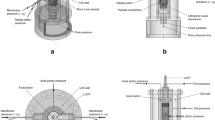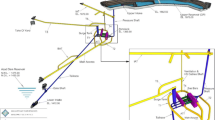Abstract
Insitu reservoir stress measurements are essential from geomechanics perspective to efficiently develop an oil and gas field. Wireline conveyed mini-frac tests gives accurate measurements of minimum horizontal stress. Wireline conveyed mini-frac test was performed in the clastic cretaceous syn-rift high pressure (9000 psi) gas bearing sandstone reservoir of an offshore deep-water well (water depth—1108 m) in Krishna-Godavari basin of East Coast off India in order to determine the insitu reservoir stresses. All the mini-frac tests attempted within the syn-rift reservoir were unsuccessful to achieve the formation breakdown pressure even with the applied pressures significantly higher than the vertical stress. This paper discusses the post-job investigation of all these unsuccessful mini-frac tests within the reservoir. Distinct large plastic deformation behaviors were identified in all these test. This investigation in conjunction with rock mechanics data derived from core samples suggest that strong relationship exist between pore fluid pressure and rock mechanical properties. High pore fluid pressure within the reservoir has made sandstone rocks mechanically weak and ductile in nature. The distinct large plastic deformation behaviors are the manifestation of this reservoir ductility. Awareness and evaluation of rock ductility in high overpressured reservoir condition is necessary during planning stages of mini-frac stress testing job. Additionally, paper shows that the rock mechanical properties plays significant role on rock deformation mode within reservoir with pressure depletion during production phase. Paper demonstrates the effective use of rock mechanical properties to predict the brittle–ductile (B–D) transition value in Q–P space (differential stress vs. mean effective stress), which will help in forecasting the reservoir deformation mode during field production stage. Furthermore, the paper highlights the importance of performing critical laboratory tests to aid significant value in field development program from geomechanics perspective.









Similar content being viewed by others
Abbreviations
- B–D transition:
-
Brittle–ductile transition
- GPa:
-
Gigapascal
- KG:
-
Krishna-Godavari
- LOP:
-
Leak-off pressure
- MEM:
-
Mechanical earth model
- MPa:
-
Megapascal
- MST:
-
Multi stage tri-axial test
- PR:
-
Poisson’s ratio
- PPG:
-
Pounds per gallon
- PSI:
-
Pounds per square inch
- PVC:
-
Pore volume compressibility
- Q–P:
-
Differential stress versus mean effective stress
- SST:
-
Single stage tri-axial test
- UCS:
-
Uniaxial compressive strength test
- VES:
-
Vertical effective stress
- YM:
-
Young’s modulus
References
Bai M (2011) Risk and uncertainties in determining fracture gradient and closure pressure. In: 45th US rock mechanics/geomechanics symposium. American Rock Mechanics Association
Bale A, Fossen H, Berg E, Kui TW (2008) Comprehensive mini-frac testing in the Gullfaks field as a tool for characterisation of reservoir structure and rock mechanics. In: International petroleum technology conference
Bastia R, Nayak P, Singh P (2007) Shelf delta to deepwater basin: a depositional model for Krishna-Godavari basin. Search Discov Art 40231:5–8
Chan AW, Zoback MD (2002) Deformation analysis in reservoir space (DARS): a simple formalism for prediction of reservoir deformation with depletion. In: SPE/ISRM rock mechanics conference. Society of Petroleum Engineers
Cig K, Al Mandhari AS, Elmsallati SM, Qobi L (2009) Advances in wireline conveyed in situ reservoir stress testing measurements: case studies from the Sultanate of Oman. In: International petroleum technology conference
Collins PM (2002) Geomechanics and wellbore stability design of an offshore horizontal well, North Sea. In: SPE international thermal operations and heavy oil symposium and international horizontal well technology conference. Society of Petroleum Engineers
Crawford BR, Sanz PF, Alramahi B, DeDontney NL (2011) Modeling and prediction of formation compressibility and compactive pore collapse in siliciclastic reservoir rocks. In: 45th US rock mechanics/geomechanics symposium. American Rock Mechanics Association
Desroches J, Kurkjian AL (1999) Applications of wireline stress measurements. SPE Reserv Eval Eng 2(05):451–461
Grieser WV, Bray JM (2007) Identification of production potential in unconventional reservoirs. In: Production and operations symposium. Society of Petroleum Engineers
Hubbert MK, Willis DG (1957) Mechanics of hydraulic fracturing. Trans SPE-AIME 210:153–168
Knipe RJ (1986) Deformation mechanism path diagrams for sediments undergoing lithification. Geol Soc Am Mem 166:151–160
Li X, Feng Z, Han G, Elsworth D, Marone C, Saffer D, Cheon DS (2016) Breakdown pressure and fracture surface morphology of hydraulic fracturing in shale with H2O, CO2 and N2. Geomech Geophys Geo-Energy Geo-Resour 2(2):63–76
Perez Altamar R, Marfurt K (2014) Mineralogy-based brittleness prediction from surface seismic data: application to the Barnett Shale. Interpretation 2(4):T255–T271
Rao GN (2001) Sedimentation, stratigraphy, and petroleum potential of Krishna-Godavari basin, East Coast of India. AAPG Bull 85(9):1623–1643
Ricard Y, Bercovici D (2003) Two-phase damage theory and crustal rock failure: the theoretical ‘void’limit, and the prediction of experimental data. Geophys J Int 155(3):1057–1064
Schutjens PMTM, Hanssen TH, Hettema MHH, Merour J, De Bree P, Coremans JWA, Helliesen G (2004) Compaction-induced porosity/permeability reduction in sandstone reservoirs: data and model for elasticity-dominated deformation. SPE Reserv Eval Eng 7(03):202–216
Wiprut D, Zoback MD (2002) Fault reactivation, leakage potential, and hydrocarbon column heights in the northern North Sea. Nor Pet Soc Spec Publ 11:203–219
Zhu W, Montesi LG, Wong TF (1997) Shear-enhanced compaction and permeability reduction: triaxial extension tests on porous sandstone. Mech Mater 25(3):199–214
Zhu W, Montési LG, Wong TF (2007) A probabilistic damage model of stress-induced permeability anisotropy during cataclastic flow. J Geophys Res Solid Earth 112(B10):B10207
Zoback MD, Zinke JC (2002) Production-induced normal faulting in the Valhall and Ekofisk oil fields. In: The mechanism of induced seismicity, pp 403–420. Birkhäuser Basel
Zoback MD, Barton CA, Brudy M, Castillo DA, Finkbeiner T, Grollimund BR, Moos DB, Peska P, Ward CD, Wiprut DJ (2003) Determination of stress orientation and magnitude in deep wells. Int J Rock Mech Min Sci 40(7):1049–1076
Acknowledgements
We thank and appreciate the critical inputs received from the reviewer that helped us to improve the contents of the paper. We would like to thanks Reliance Industries Ltd., (E, P) Petroleum Business for giving us the permission to publish this paper.
Author information
Authors and Affiliations
Corresponding author
SI metric conversion factors
SI metric conversion factors
1 g/cm3 = 9.81 MPa/km | 1 ppg = 0.051948 psi/ft |
1 g/cm3 = 0.00981 MPa/m | 1 ppg = 0.12 g/cm3 |
1 g/cm3 = 1 SG | 1 ppg = 0.12 SG |
1 MPa/km = 0.102 SG = 0.102 g/cm3 | 1 ppg = 1.177 MPa/km |
1 MPa/km = 1 kPa/m | 1 ppg = 1.177 kPa/m |
1 g/cm3 = 8.345 ppg | 1 psi/ft = 19.25 ppg |
1 g/cm3 = 0.4335 psi/ft | 1 psi/ft = 2.31 g/cm3 |
1 SG = 8.345 ppg | 1 psi/ft = 22.66 MPa/km |
1 SG = 0.4335 psi/ft | 1 psi/ft = 2.31 SG |
1 MPa = 10^6 Pa | 1 GPa = 10^3 MPa |
Rights and permissions
About this article
Cite this article
Dutta, J., Bhardwaj, N. & Kumar, A. Integration of mini-frac stress results with core data to identify ductile behavior of overpressured sandstone reservoir in deep-water offshore Krishna-Godavari basin, India. Geomech. Geophys. Geo-energ. Geo-resour. 4, 11–28 (2018). https://doi.org/10.1007/s40948-017-0071-5
Received:
Accepted:
Published:
Issue Date:
DOI: https://doi.org/10.1007/s40948-017-0071-5




